 Technology peripherals
Technology peripherals
 AI
AI
 Is the Llama architecture inferior to GPT2? Magical token improves memory 10 times?
Is the Llama architecture inferior to GPT2? Magical token improves memory 10 times?
Is the Llama architecture inferior to GPT2? Magical token improves memory 10 times?
How much human knowledge can a 7B scale language model LLM store? How to quantify this value? How will differences in training time and model architecture affect this value? What impact will floating-point compression quantization, mixed expert model MoE, and differences in data quality (encyclopedia knowledge vs. Internet garbage) have on the knowledge capacity of LLM?
The latest research by Zhu Zeyuan (Meta AI) and Li Yuanzhi (MBZUAI) "Language Model Physics Part 3.3: Scaling Laws of Knowledge" uses massive experiments (50,000 tasks, a total of 4,200,000 GPU hours ) summarizes 12 laws and provides a more accurate measurement method for the knowledge capacity of LLM under different documents.
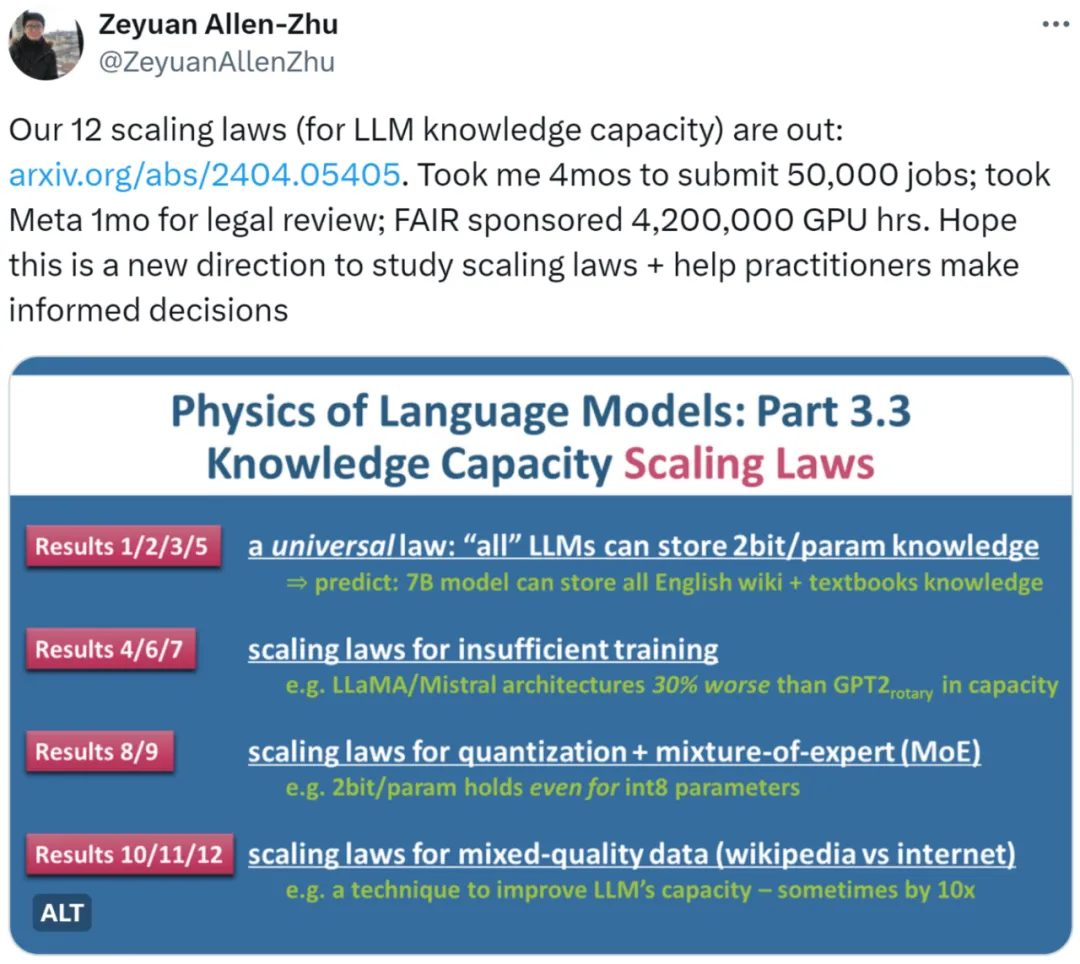
The author first points out that it is unrealistic to measure the scaling law of LLM through the performance of open source models on benchmark data sets (benchmark). For example, LLaMA-70B performs 30% better than LLaMA-7B on the knowledge data set. This does not mean that expanding the model by 10 times can only increase the capacity by 30%. If a model is trained using network data, it will also be difficult to estimate the total amount of knowledge contained in it.
For another example, when we compare the quality of the Mistral and Llama models, is the difference caused by their different model architectures, or is it caused by the different preparation of their training data?
Based on the above considerations, the author adopts the core idea of their "Language Model Physics" series of papers, which is to create artificially synthesized data and strictly control the amount and type of knowledge in the data. Regulate the knowledge bits in the data. At the same time, the author uses LLMs of different sizes and architectures to train on synthetic data, and gives mathematical definitions to accurately calculate how many bits of knowledge the trained model has learned from the data.
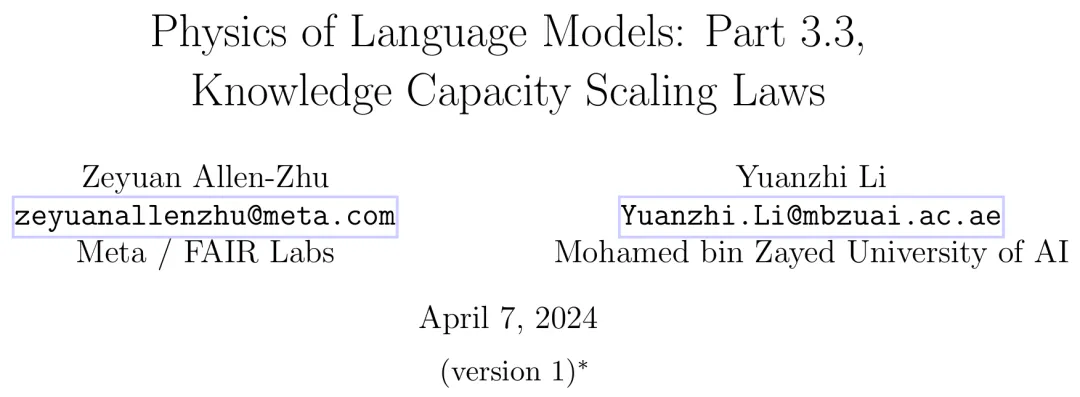
- Paper address: https://arxiv.org/pdf/2404.05405.pdf
- Paper title: Physics of Language Models: Part 3.3, Knowledge Capacity Scaling Laws
For this research, someone It seems reasonable to indicate this direction. We can analyze scaling law in a very scientific way.

Some people also believe that this research takes scaling law to a different level. Certainly a must-read paper for practitioners.
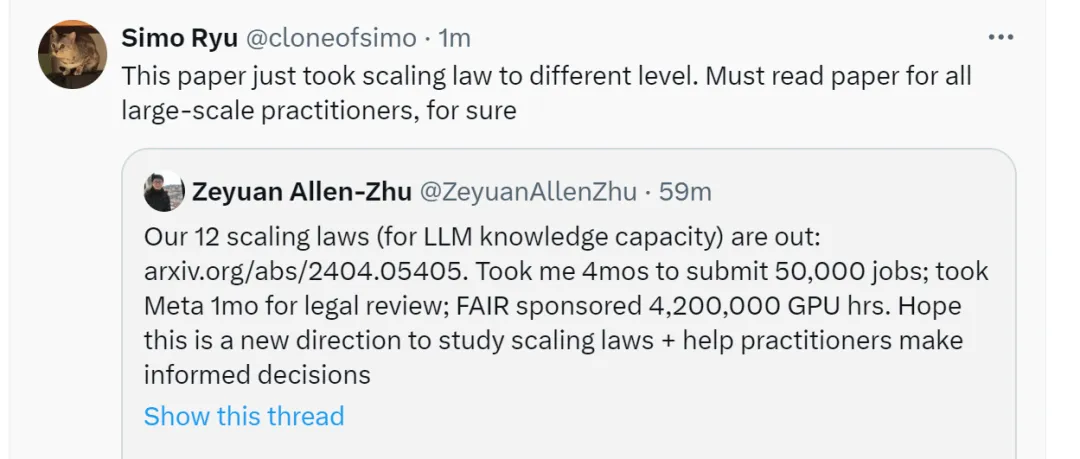
Research Overview
The authors studied three types of synthetic data: bioS, bioR, bioD . bioS is a biography written using English templates, bioR is a biography written with the help of the LlaMA2 model (22GB total), bioD is a kind of virtual knowledge data that can further control the details (for example, the length of the knowledge and the vocabulary can be controlled Wait for details). The author focuses on the language model architecture based on GPT2, LlaMA, and Mistral, among which GPT2 uses the updated Rotary Position Embedding (RoPE) technology.

The picture on the left shows the scaling laws with sufficient training time, and the picture on the right shows scaling laws with insufficient training time
Top Figure 1 briefly summarizes the first 5 laws proposed by the author. The left/right correspond to the two situations of "sufficient training time" and "insufficient training time" respectively, which respectively correspond to common knowledge (such as the capital of China is Beijing) and less Emerging knowledge (for example, the Department of Physics at Tsinghua University was established in 1926).
If the training time is sufficient, the author found that no matter which model architecture is used, GPT2 or LlaMA/Mistral, the storage efficiency of the model can reach 2bit/param - that is, the average per model Parameters can store 2 bits of information. This has nothing to do with model depth, only model size. In other words, a 7B model, if adequately trained, can store 14B bits of knowledge, which is more than the human knowledge in Wikipedia and all English textbooks combined!
What is even more surprising is that although the traditional theory is that the knowledge in the transformer model is mainly stored in the MLP layer, the author's research refutes this view. They found that even if all MLP layers are removed, the model still It can achieve a storage efficiency of 2bit/param.
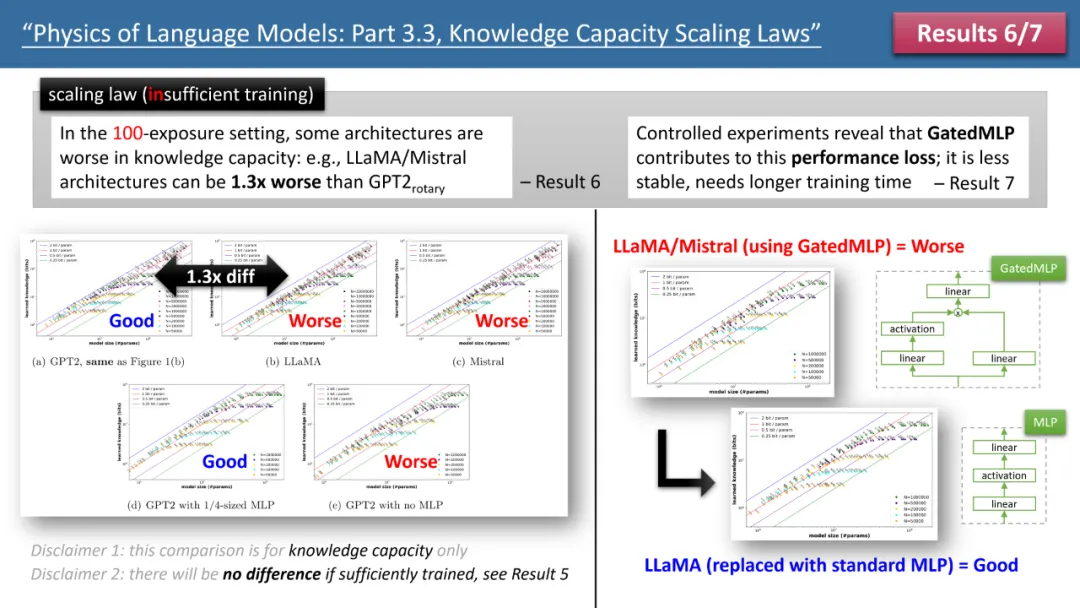
Figure 2: Scaling laws when training time is insufficient
However, when we observe the training When time is insufficient, differences between models become apparent. As shown in Figure 2 above, in this case, the GPT2 model can store 30% more knowledge than LlaMA/Mistral, which means that the model from a few years ago surpasses today's model in some aspects. Why is this happening? The author made architectural adjustments on the LlaMA model, adding or subtracting each difference between the model and GPT2, and finally found that GatedMLP caused the 30% loss.
To emphasize, GatedMLP does not cause a change in the "final" storage rate of the model - because Figure 1 tells us that they will not be different if the training is sufficient. However, GatedMLP will lead to unstable training, so the same knowledge requires longer training time; in other words, for knowledge that rarely appears in the training set, the storage efficiency of the model will decrease.
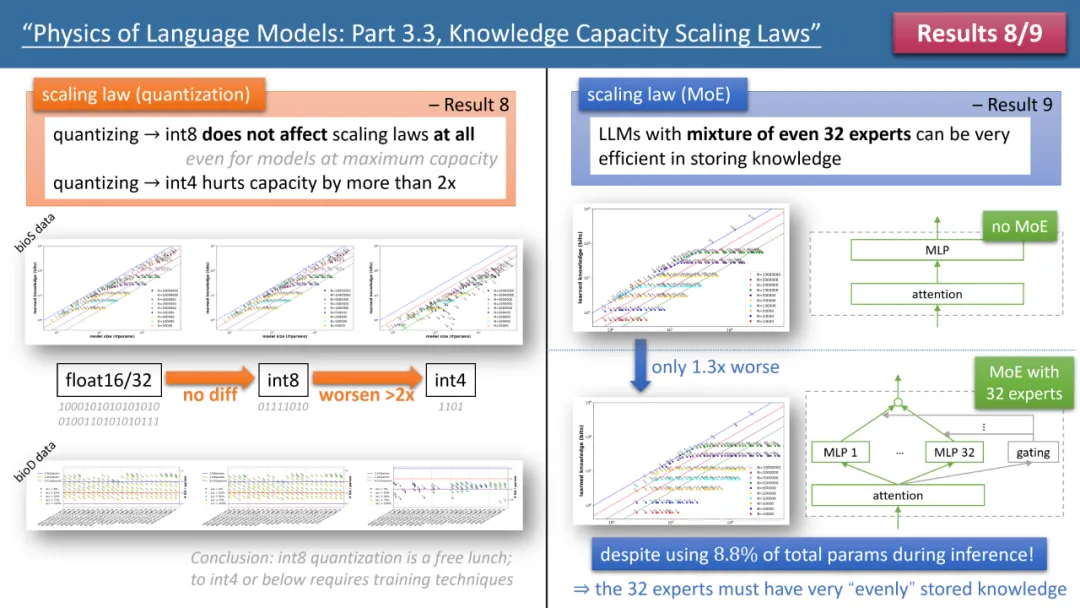
The author’s laws 8 and Law 9 separately studies the impact of quantization and MoE on the model scaling law, and the conclusion is shown in Figure 3 above. One result is that compressing the trained model from float32/16 to int8 has no impact on the storage of knowledge, even for models that have reached the 2bit/param storage limit.
This means that LLM can reach 1/4 of the "information theory limit" - because the int8 parameter is only 8 bits, but on average each parameter can store 2 bits of knowledge. The author points out that this is a universal law and has nothing to do with the form of knowledge expression.
The most striking results come from the authors’ laws 10-12 (see Figure 4). If our (pre-)training data, 1/8 comes from high-quality knowledge bases (such as Baidu Encyclopedia), and 7/8 comes from low-quality data (such as common crawl or forum conversations, or even completely random garbage data).
So,
Will low-quality data affect LLM’s absorption of high-quality knowledge? The results are surprising. Even if the training time for high-quality data remains consistent, the "existence itself" of low-quality data may reduce the model's storage of high-quality knowledge by 20 times! Even if the training time on high-quality data is extended by 3 times, the knowledge reserve will still be reduced by 3 times. This is like throwing gold into the sand, and high-quality data is being wasted.
Is there any way to fix it? The author proposed a simple but extremely effective strategy, which simply adds your own website domain name token to all (pre)training data. For example, add all Wikipedia data to wikipedia.org. The model does not require any prior knowledge to identify which websites have "gold" knowledge, but canautomatically discover websites with high-quality knowledge during the pre-training process, and automatically This high-quality data frees up storage space.
The author proposed a simple experiment to verify: if high-quality data is added with a special token (any special token will do, the model does not need to know which token it is in advance), then The knowledge storage capacity of the model can be increased by 10 times immediately. Isn’t it amazing? Therefore, adding domain name token to pre-training data is an extremely important data preparation operation.
Figure 4: Scaling laws, model defects and how to repair them when pre-training data has "inconsistent knowledge quality"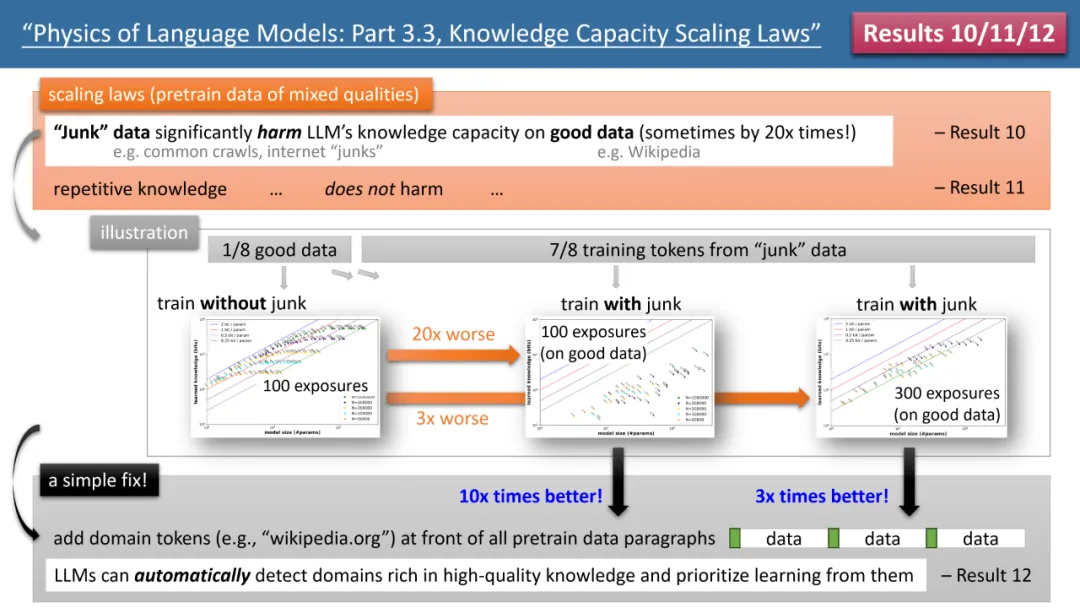
Conclusion
The author believes that by synthesizing data, the method of calculating the total amount of knowledge obtained by the model during the training process can be used to "evaluate the model architecture, training methods and "Data Preparation" provides a systematic and accurate scoring system. This is completely different from traditional benchmark comparisons and is more reliable. They hope this will help designers of future LLMs make more informed decisions.
The above is the detailed content of Is the Llama architecture inferior to GPT2? Magical token improves memory 10 times?. For more information, please follow other related articles on the PHP Chinese website!

Hot AI Tools

Undresser.AI Undress
AI-powered app for creating realistic nude photos

AI Clothes Remover
Online AI tool for removing clothes from photos.

Undress AI Tool
Undress images for free

Clothoff.io
AI clothes remover

AI Hentai Generator
Generate AI Hentai for free.

Hot Article

Hot Tools

Notepad++7.3.1
Easy-to-use and free code editor

SublimeText3 Chinese version
Chinese version, very easy to use

Zend Studio 13.0.1
Powerful PHP integrated development environment

Dreamweaver CS6
Visual web development tools

SublimeText3 Mac version
God-level code editing software (SublimeText3)

Hot Topics
 1377
1377
 52
52
 Open source! Beyond ZoeDepth! DepthFM: Fast and accurate monocular depth estimation!
Apr 03, 2024 pm 12:04 PM
Open source! Beyond ZoeDepth! DepthFM: Fast and accurate monocular depth estimation!
Apr 03, 2024 pm 12:04 PM
0.What does this article do? We propose DepthFM: a versatile and fast state-of-the-art generative monocular depth estimation model. In addition to traditional depth estimation tasks, DepthFM also demonstrates state-of-the-art capabilities in downstream tasks such as depth inpainting. DepthFM is efficient and can synthesize depth maps within a few inference steps. Let’s read about this work together ~ 1. Paper information title: DepthFM: FastMonocularDepthEstimationwithFlowMatching Author: MingGui, JohannesS.Fischer, UlrichPrestel, PingchuanMa, Dmytr
 The world's most powerful open source MoE model is here, with Chinese capabilities comparable to GPT-4, and the price is only nearly one percent of GPT-4-Turbo
May 07, 2024 pm 04:13 PM
The world's most powerful open source MoE model is here, with Chinese capabilities comparable to GPT-4, and the price is only nearly one percent of GPT-4-Turbo
May 07, 2024 pm 04:13 PM
Imagine an artificial intelligence model that not only has the ability to surpass traditional computing, but also achieves more efficient performance at a lower cost. This is not science fiction, DeepSeek-V2[1], the world’s most powerful open source MoE model is here. DeepSeek-V2 is a powerful mixture of experts (MoE) language model with the characteristics of economical training and efficient inference. It consists of 236B parameters, 21B of which are used to activate each marker. Compared with DeepSeek67B, DeepSeek-V2 has stronger performance, while saving 42.5% of training costs, reducing KV cache by 93.3%, and increasing the maximum generation throughput to 5.76 times. DeepSeek is a company exploring general artificial intelligence
 AI subverts mathematical research! Fields Medal winner and Chinese-American mathematician led 11 top-ranked papers | Liked by Terence Tao
Apr 09, 2024 am 11:52 AM
AI subverts mathematical research! Fields Medal winner and Chinese-American mathematician led 11 top-ranked papers | Liked by Terence Tao
Apr 09, 2024 am 11:52 AM
AI is indeed changing mathematics. Recently, Tao Zhexuan, who has been paying close attention to this issue, forwarded the latest issue of "Bulletin of the American Mathematical Society" (Bulletin of the American Mathematical Society). Focusing on the topic "Will machines change mathematics?", many mathematicians expressed their opinions. The whole process was full of sparks, hardcore and exciting. The author has a strong lineup, including Fields Medal winner Akshay Venkatesh, Chinese mathematician Zheng Lejun, NYU computer scientist Ernest Davis and many other well-known scholars in the industry. The world of AI has changed dramatically. You know, many of these articles were submitted a year ago.
 Hello, electric Atlas! Boston Dynamics robot comes back to life, 180-degree weird moves scare Musk
Apr 18, 2024 pm 07:58 PM
Hello, electric Atlas! Boston Dynamics robot comes back to life, 180-degree weird moves scare Musk
Apr 18, 2024 pm 07:58 PM
Boston Dynamics Atlas officially enters the era of electric robots! Yesterday, the hydraulic Atlas just "tearfully" withdrew from the stage of history. Today, Boston Dynamics announced that the electric Atlas is on the job. It seems that in the field of commercial humanoid robots, Boston Dynamics is determined to compete with Tesla. After the new video was released, it had already been viewed by more than one million people in just ten hours. The old people leave and new roles appear. This is a historical necessity. There is no doubt that this year is the explosive year of humanoid robots. Netizens commented: The advancement of robots has made this year's opening ceremony look like a human, and the degree of freedom is far greater than that of humans. But is this really not a horror movie? At the beginning of the video, Atlas is lying calmly on the ground, seemingly on his back. What follows is jaw-dropping
 KAN, which replaces MLP, has been extended to convolution by open source projects
Jun 01, 2024 pm 10:03 PM
KAN, which replaces MLP, has been extended to convolution by open source projects
Jun 01, 2024 pm 10:03 PM
Earlier this month, researchers from MIT and other institutions proposed a very promising alternative to MLP - KAN. KAN outperforms MLP in terms of accuracy and interpretability. And it can outperform MLP running with a larger number of parameters with a very small number of parameters. For example, the authors stated that they used KAN to reproduce DeepMind's results with a smaller network and a higher degree of automation. Specifically, DeepMind's MLP has about 300,000 parameters, while KAN only has about 200 parameters. KAN has a strong mathematical foundation like MLP. MLP is based on the universal approximation theorem, while KAN is based on the Kolmogorov-Arnold representation theorem. As shown in the figure below, KAN has
 Slow Cellular Data Internet Speeds on iPhone: Fixes
May 03, 2024 pm 09:01 PM
Slow Cellular Data Internet Speeds on iPhone: Fixes
May 03, 2024 pm 09:01 PM
Facing lag, slow mobile data connection on iPhone? Typically, the strength of cellular internet on your phone depends on several factors such as region, cellular network type, roaming type, etc. There are some things you can do to get a faster, more reliable cellular Internet connection. Fix 1 – Force Restart iPhone Sometimes, force restarting your device just resets a lot of things, including the cellular connection. Step 1 – Just press the volume up key once and release. Next, press the Volume Down key and release it again. Step 2 – The next part of the process is to hold the button on the right side. Let the iPhone finish restarting. Enable cellular data and check network speed. Check again Fix 2 – Change data mode While 5G offers better network speeds, it works better when the signal is weaker
 The vitality of super intelligence awakens! But with the arrival of self-updating AI, mothers no longer have to worry about data bottlenecks
Apr 29, 2024 pm 06:55 PM
The vitality of super intelligence awakens! But with the arrival of self-updating AI, mothers no longer have to worry about data bottlenecks
Apr 29, 2024 pm 06:55 PM
I cry to death. The world is madly building big models. The data on the Internet is not enough. It is not enough at all. The training model looks like "The Hunger Games", and AI researchers around the world are worrying about how to feed these data voracious eaters. This problem is particularly prominent in multi-modal tasks. At a time when nothing could be done, a start-up team from the Department of Renmin University of China used its own new model to become the first in China to make "model-generated data feed itself" a reality. Moreover, it is a two-pronged approach on the understanding side and the generation side. Both sides can generate high-quality, multi-modal new data and provide data feedback to the model itself. What is a model? Awaker 1.0, a large multi-modal model that just appeared on the Zhongguancun Forum. Who is the team? Sophon engine. Founded by Gao Yizhao, a doctoral student at Renmin University’s Hillhouse School of Artificial Intelligence.
 The U.S. Air Force showcases its first AI fighter jet with high profile! The minister personally conducted the test drive without interfering during the whole process, and 100,000 lines of code were tested for 21 times.
May 07, 2024 pm 05:00 PM
The U.S. Air Force showcases its first AI fighter jet with high profile! The minister personally conducted the test drive without interfering during the whole process, and 100,000 lines of code were tested for 21 times.
May 07, 2024 pm 05:00 PM
Recently, the military circle has been overwhelmed by the news: US military fighter jets can now complete fully automatic air combat using AI. Yes, just recently, the US military’s AI fighter jet was made public for the first time and the mystery was unveiled. The full name of this fighter is the Variable Stability Simulator Test Aircraft (VISTA). It was personally flown by the Secretary of the US Air Force to simulate a one-on-one air battle. On May 2, U.S. Air Force Secretary Frank Kendall took off in an X-62AVISTA at Edwards Air Force Base. Note that during the one-hour flight, all flight actions were completed autonomously by AI! Kendall said - "For the past few decades, we have been thinking about the unlimited potential of autonomous air-to-air combat, but it has always seemed out of reach." However now,



